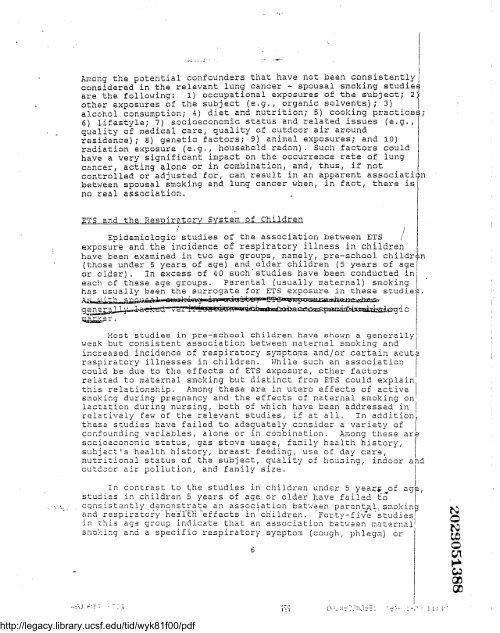ets exposure, lung cancer - Legacy Tobacco Documents Library
ets exposure, lung cancer - Legacy Tobacco Documents Library
ets exposure, lung cancer - Legacy Tobacco Documents Library
Create successful ePaper yourself
Turn your PDF publications into a flip-book with our unique Google optimized e-Paper software.
Among the potential confounders that have not been consistently~<br />
considered in the relevant <strong>lung</strong> <strong>cancer</strong> - spousal smoking studieff<br />
are the following : 1) occupational <strong>exposure</strong>s of the subject ; 2)<br />
other <strong>exposure</strong>s of the subject (e .g ., organic solvents) ; 3)<br />
alcohol consumption ; 4) diet and nutrition ; 5) cooking pr.actice ;<br />
6) lifestyle ; 7) socioeconomic status and related issues (e .g .,<br />
quality of medical care, quality of outdoor air around<br />
residence) ; 8) genetic factors ; 9) animal <strong>exposure</strong>s ; and lo)<br />
radiation <strong>exposure</strong> (e,g ., household radon) . Such factors could<br />
have a very significant inipact on the occurrence rate of <strong>lung</strong> ~<br />
<strong>cancer</strong>, acting alone or in combination, and, thus, if not<br />
controlled or adjusted for, can result in an apparent associatic,n<br />
between spousal smoking and <strong>lung</strong> <strong>cancer</strong> when, in fact, there is<br />
no real association .<br />
F9'Sard the RespiratorrL System of Children<br />
i<br />
Epidemiologic studies of the association between ETS %<br />
<strong>exposure</strong> and the incidence of respiratory illness in children<br />
have been examined in two age groups, namely, pre-school childr n<br />
(those under 5 years of age) and older children (5 y-ears of age<br />
or older) . In excess of 40 such'studies have been conducted ini<br />
each of these age groups . Parental (usually maternal) smoking ,<br />
has usually been the surrogate for ETS <strong>exposure</strong> in these studies .<br />
g`Pn s ~ c<br />
~r .<br />
i;ost studies in pre-school children have shown a generally ;<br />
weak but consistent association between maternal .smoking an `d<br />
increased incidence of respiratory symptoms and/or certain acutY<br />
respiratory illnesses in children . t•ihile such an association ~<br />
could be due to the effects of ETS <strong>exposure</strong>, other factor is<br />
related to maternal smoking but distinct from ETS could explain :<br />
this relationship . Among these are in utero effects of active<br />
smoking during pregnancy and the effects of maternal smoking on,<br />
lactation during nursing, both of which have been addressed in i<br />
relatively few of the relevant studies, i= at all . in addition ;<br />
these studies have failed to adequately consider a variety o (f<br />
confounding variables, alone or in co-mbination . P_:uong these ar~<br />
socio2conc,,ic status, gas stove usage, family health history I,<br />
subject's health history, breast feeding, use of day care, ~<br />
nutritional status of the subject, quality of housing, indoor aT1d<br />
outdoor air pollution, and fanily size . I<br />
In contrast to the studies in children under 5 ye,aj~~F, of ag<br />
studies in children 5 years of age or older have failed to<br />
cqnsistently .demonstrate an association between parcnt~l ;$7okinp<br />
and rzspiratory he'i1'tli -effects'in cliildren . Forty-fii~e'studies~<br />
in this age group indic : te that an association between matnrj ;all<br />
sne :,:ing and a specific respiratory symptom (cough, phlegn) or ~<br />
http://legacy.library.ucsf.edu/tid/wyk81f00/pdf<br />
6<br />
,

















